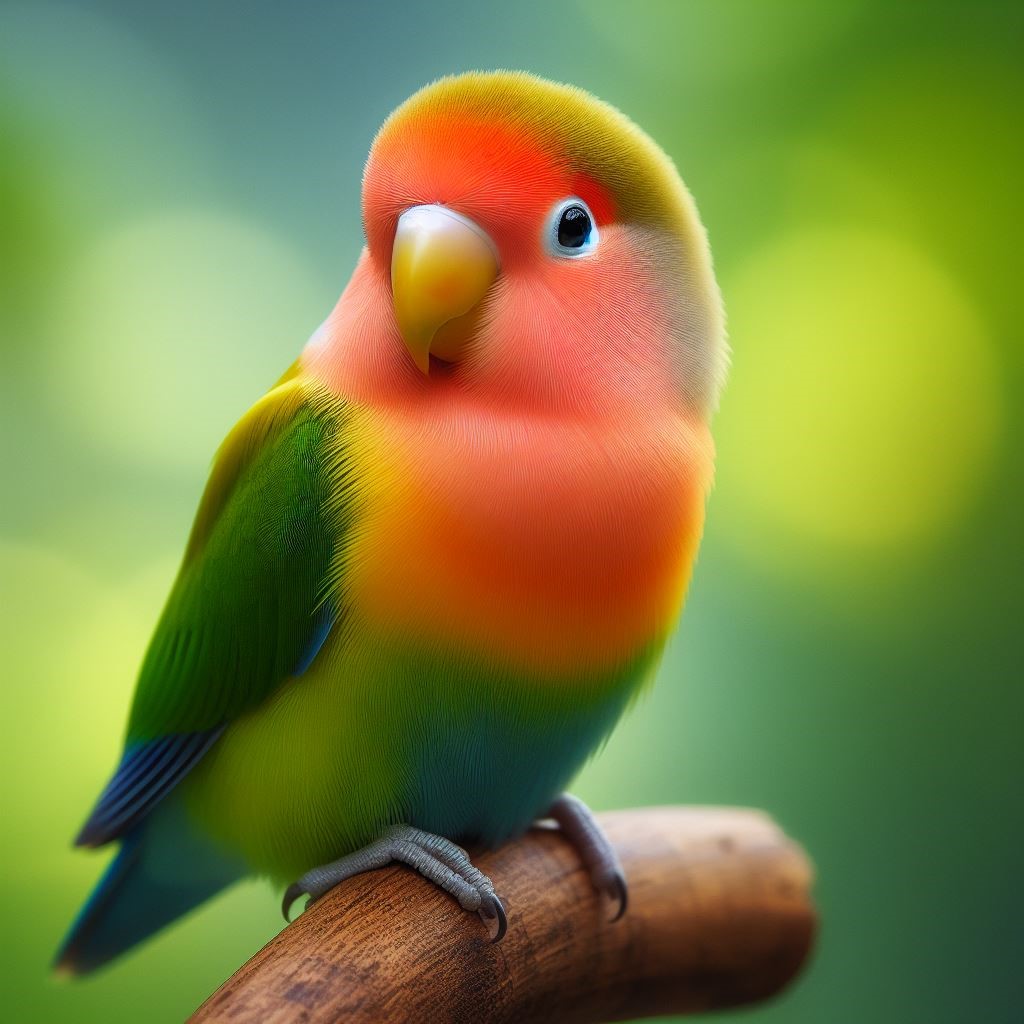Have you ever come across a peach-faced lovebird? These small, colorful parrots are a joy to behold, with their vibrant plumage and lively personalities. In this comprehensive guide, we’ll explore everything you need to know about peach-faced lovebirds, from their origins and natural habitat to their care requirements and behavior.

Table of Contents
ToggleOrigins of the Peach-Faced Lovebird
Peach-faced lovebirds, also known as rosy-faced lovebirds, originate from the dry regions of southwestern Africa, particularly Namibia and Angola. These small parrots are members of the Agapornis genus and are closely related to other lovebird species.
Physical Characteristics
Peach-faced lovebirds are known for their vibrant plumage, with shades of green, yellow, and orange dominating their appearance. Their name comes from the peach-colored face and throat of the adult birds, which contrasts beautifully with their green body feathers.
Color Varieties
While the wild-type peach-faced lovebird is predominantly green with a peach face, breeders have developed several color mutations over the years. These include blue, violet, and lutino variations, each with its own unique charm.
| Color Variety | Description |
|---|---|
| Wild Type | Predominantly green body with a peach-colored face and throat |
| Blue | Blue body with a lighter blue or white face and throat |
| Violet | Purple body with a lighter purple or white face and throat |
| Lutino | Yellow body with a pale yellow or white face and throat |
| Albino | White body with red or pink eyes and a white face and throat |
| Cinnamon | Brownish body with a cinnamon-colored face and throat |
| Pied | Variegated pattern of colors on the body, including patches of white, green, and other hues |
| Dilute | Soft, muted colors on the body, with a lighter face and throat |
Habitat and Natural Behavior
In the wild, peach-faced lovebirds are social creatures that form strong bonds with their mates. They are often found in flocks, foraging for food and nesting in tree hollows. These birds are known for their playful nature and can be seen engaging in various activities, such as preening and chirping.
Diet and Feeding
A balanced diet is essential for the health and well-being of peach-faced lovebirds. In the wild, they feed on a variety of seeds, fruits, and vegetation. In captivity, it’s important to provide them with a diet that includes a mix of seeds, pellets, fruits, and vegetables to ensure they receive all the necessary nutrients.
Caring for Peach-Faced Lovebirds
Proper care is crucial for the health and happiness of peach-faced lovebirds. This includes providing them with a spacious cage, regular veterinary check-ups, and plenty of opportunities for exercise and socialization. Additionally, it’s important to provide them with toys and mental stimulation to prevent boredom.
Health Concerns
Like all pets, peach-faced lovebirds are prone to certain health issues. Common health concerns include respiratory infections, feather plucking, and obesity. Regular veterinary check-ups and a healthy diet can help prevent these issues.
Breeding and Reproduction
Breeding peach-faced lovebirds can be a rewarding experience. However, it’s important to ensure that both the male and female birds are healthy and of breeding age. Providing them with a suitable nesting box and a diet rich in calcium can help encourage breeding behavior.
Training and Socialization
Peach-faced lovebirds are intelligent birds that can be trained to do various tricks and behaviors. Positive reinforcement techniques, such as clicker training, can be used to teach them new skills. Socialization is also important, as it helps prevent behavioral issues such as aggression and fearfulness.
Interacting with Your Lovebird
Interacting with your peach-faced lovebird can be a delightful experience. These birds are known for their playful and affectionate nature, and they often form strong bonds with their human companions. Spending quality time with your lovebird, such as talking to them and offering them treats, can help strengthen your bond.
Common Myths and Misconceptions
There are several myths and misconceptions surrounding peach-faced lovebirds. One common myth is that they require minimal care and attention, which is not true. These birds require a significant amount of time and effort to ensure they remain healthy and happy.
Conclusion
In conclusion, peach-faced lovebirds are fascinating creatures that make wonderful pets. Their vibrant colors, playful nature, and affectionate personalities make them a joy to be around. By providing them with proper care, a balanced diet, and plenty of love and attention, you can enjoy a rewarding relationship with your peach-faced lovebird for years to come.
FAQs
- Q: How long do peach-faced lovebirds live? A: Peach-faced lovebirds can live up to 15 years or more with proper care.
- Q: Do peach-faced lovebirds require special grooming? A: Peach-faced lovebirds groom themselves regularly and do not require special grooming from their owners.
- Q: Can peach-faced lovebirds be kept as single pets? A: While peach-faced lovebirds are social birds that thrive in pairs or groups, they can be kept as single pets with proper socialization and attention from their owners.
- Q: Do peach-faced lovebirds talk? A: While peach-faced lovebirds are not known for their talking ability, they can mimic sounds and whistles.
- Q: Are peach-faced lovebirds noisy? A: Peach-faced lovebirds can be noisy, especially during their active times, but their vocalizations are generally not as loud as some other parrot species.
By following these guidelines, you can ensure that your peachfaced lovebird remains healthy, happy, and well-adjusted in its new environment. With proper care and attention, your lovebird can live a long and fulfilling life as a cherished member of your family.






